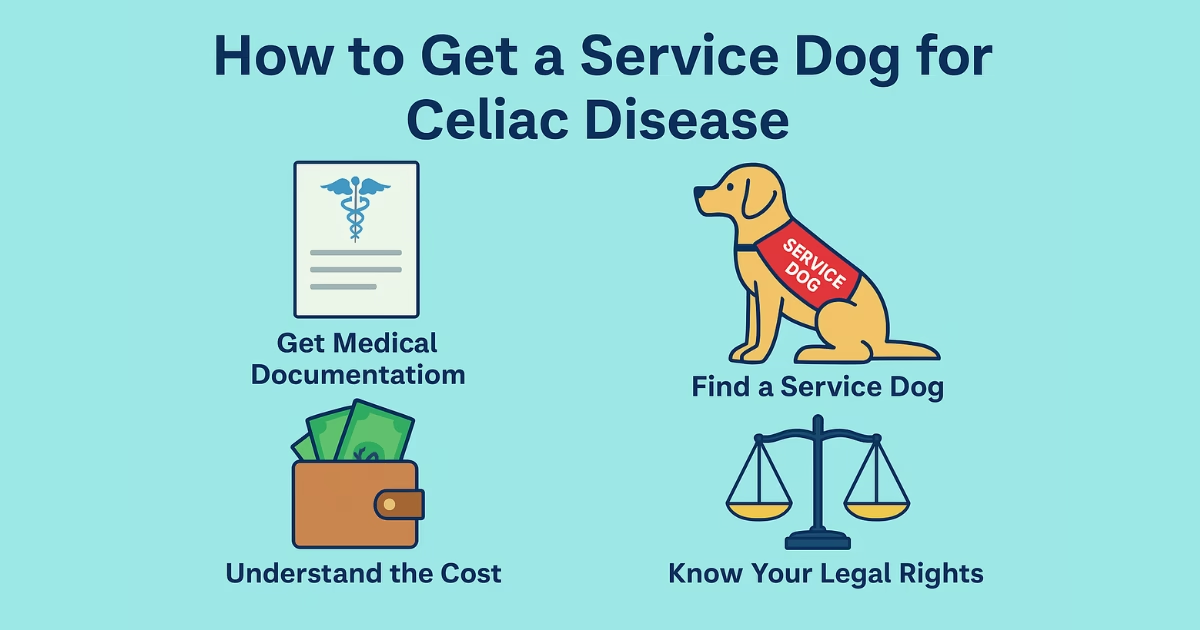Living with celiac disease means more than avoiding bread or pasta. For many, even the smallest trace of gluten can trigger severe reactions, making everyday life a challenge. While reading labels and asking questions at restaurants helps, it’s not always foolproof. That’s where a gluten-detection service dog can change everything.
These specially trained dogs can sniff out gluten in food, surfaces, or even cosmetics, offering an extra layer of protection. For individuals with severe sensitivity or frequent accidental exposure, a service dog can provide both safety and peace of mind.
In this blog post, we’ll walk you through how to get a service dog for celiac disease. From understanding eligibility requirements to choosing the right training program, this guide covers every important step to help you decide if a gluten-sniffing service dog is right for you.
How to Get a Service Dog for Celiac Disease
Getting a service dog for celiac disease involves more than just filling out an application. It starts with understanding whether you meet the legal and medical criteria. Not everyone with celiac disease qualifies. According to the Americans with Disabilities Act (ADA), you must have a physical or mental impairment that substantially limits one or more major life activities.
This means that only people who experience severe reactions, face serious risks from accidental gluten exposure, or have difficulty managing their condition with diet alone are typically considered eligible. If your condition makes it hard to live safely or independently, a gluten-detection service dog might be a reasonable and necessary solution.
The process also includes gathering medical documentation, choosing a reputable training organization, and preparing for the time and cost involved. Knowing how to get a service dog for celiac disease starts with being realistic about the requirements and committed to the journey.
Understanding What a Gluten Detection Dog Does
A gluten detection dog is trained to smell even tiny amounts of gluten in food, packaging, or on surfaces. These dogs have a sense of smell that’s far more powerful than any human tool. Their job is to alert their handler before gluten is consumed or touched.
These dogs are not emotional support animals. They perform specific tasks that help a person avoid harm. For example, they may sniff a plate of food and sit down if gluten is detected. Or they may alert by pawing or nudging.
This type of service dog is especially useful for people who are highly sensitive and have had multiple gluten exposures, even after taking many precautions. With a trained gluten-sniffing dog, daily life becomes safer and more manageable for someone with severe celiac disease.
Who Qualifies for a Service Dog with Celiac Disease
Not everyone with celiac disease qualifies for a service dog. To be approved, the condition must be disabling under the law. That means it limits your ability to perform major daily tasks. If your symptoms are severe, frequent, and interfere with work, school, or daily life, you may qualify.
Some examples of qualifying situations include:
- Frequent hospital visits due to gluten exposure
- Inability to eat safely at most places
- Constant risk of severe reactions despite being careful
Doctors, therapists, or specialists must confirm this in writing. This shows that the dog would help you avoid serious harm and live more independently. Without strong medical support, applications for service dogs are often denied.
Medical Documentation and Professional Support
A doctor’s note is more than a formality—it’s a requirement. Most organizations ask for proof that the service dog is medically necessary. This usually comes from a gastroenterologist or primary care provider.
The note should clearly explain:
- That you have celiac disease
- That your condition causes major life challenges
- That a gluten-detection service dog would help manage those challenges
Sometimes a mental health professional may also be involved if anxiety or trauma is part of the condition. Strong medical backing improves your chances of approval and helps the training organization understand your needs.
Where to Get a Gluten Detection Service Dog
Finding a trustworthy organization is one of the most important steps. Only a few programs train dogs to detect gluten, so do your research. Some well-known organizations include:
- Nosey Dog Detection Partners
- Willow Service Dogs
- Allergen Detection Service Dogs (U.S.-based)
Look for trainers who specialize in scent detection and have experience with gluten. Ask about success stories, wait times, and training length.
Also check if they offer support after placement. A good program will help you learn how to work with your dog and answer questions long after training ends.
Cost of a Gluten Service Dog and Funding Options
Getting a service dog can cost between $10,000 and $25,000—or more. That includes breeding, training, testing, and handler education. Many families can’t afford this upfront, so funding becomes essential.
Here are some ways to help:
- Apply to nonprofits that offer grants
- Start a GoFundMe or local fundraiser
- Look for sponsorships from community groups
- Use an HSA (Health Savings Account) if allowed
- Ask if the trainer offers payment plans
Insurance usually won’t cover service dogs, but in rare cases, flexible spending accounts or disability funds may help. Be prepared for a wait and plan finances early.
Training and Bonding with Your Service Dog
Training doesn’t stop when the dog is placed with you. You’ll need to learn how to work with your dog, reinforce their skills, and build a strong bond.
Most programs include:
- Obedience training
- Scent detection practice
- Public access training
- Handler education
The bond between dog and handler is key. The better your relationship, the more reliable the alerts will be. It takes time and patience—but the reward is a safer, more confident lifestyle.
Legal Rights and Public Access
Under the Americans with Disabilities Act (ADA), service dogs have the right to go almost everywhere their handler goes. This includes restaurants, planes, schools, and workplaces.
To be protected under the ADA:
- The dog must perform tasks directly related to your disability
- The dog must be trained and well-behaved in public
No special ID or vest is required, though many handlers use one. Businesses can ask two things:
- Is the dog a service animal required for a disability?
- What task is it trained to perform?
You don’t need to share medical details. But you must control the dog at all times.
Alternatives If You Can’t Get a Service Dog
Not everyone will qualify for or be able to afford a gluten detection dog. If that’s your case, there are still helpful options:
- Portable gluten test kits: Test small food samples before eating
- Carefully vetted food apps: Use updated guides and food scanners
- Meal prepping at home: Less risk, more control
- Support groups: Learn new coping tips from others with celiac
- Therapy pets: These don’t perform tasks but can offer comfort
A service dog is a powerful tool, but it’s not the only way to stay safe and live well with celiac disease.
Also Read: Genetic Testing for Celiac Disease: Key Insights and Benefits
Conclusion
For people with severe gluten sensitivity, knowing how to get a service dog for celiac disease can be life-changing. These dogs don’t just detect danger—they give people the freedom to live without constant fear of hidden gluten.
Getting a service dog takes time, money, and commitment. You’ll need strong medical support, the right training program, and a willingness to build a lasting bond with your dog. But for those who qualify, the reward is worth it: greater safety, independence, and peace of mind.
FAQs
Q1: Can I get a service dog just for having celiac disease?
Not always. You must show that your condition severely limits daily life and that the dog performs necessary tasks like gluten detection.
Q2: How much does a gluten detection service dog cost?
Costs range from $10,000 to $25,000 or more. Some nonprofits offer grants or financial help.
Q3: Are gluten detection dogs covered by insurance?
Most insurance plans do not cover service dogs. Some HSA or FSA funds may apply with approval.
Q4: How long does it take to get a trained gluten-sniffing dog?
The process can take several months to a few years, depending on the trainer and waitlist.
Q5: Where can I find a service dog trained for celiac disease?
Look for organizations that specialize in allergen or scent detection dogs, like Nosey Dog Detection Partners.

Hi, I’m Shafy Ali – a curious mind and passionate writer at Celiac Magazine. I cover a little bit of everything, from everyday tips and how-tos to deeper dives into topics that spark conversation. I enjoy turning research into readable, relatable content that informs and inspires. Whatever the subject, I aim to keep it clear, engaging, and genuinely useful.

